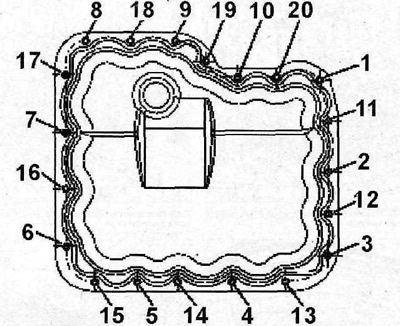SAE designation (Society of Automotive Engineers) indicates the viscosity of the engine oil.
For example, SAE 10W40 stands for:
- 10 - viscosity of the oil in a cold state; the lower this number, the lower the viscosity of cold engine oil;
- W - oil is suitable for operation in winter conditions;
- 40 - viscosity of the oil in a hot state; the higher this number, the higher the viscosity of hot engine oil.
Lightweight oils can also be used to lubricate the engine (low friction oils). We are talking about all-weather oils, which include additives that facilitate the coefficient of friction, as a result of which there is a decrease in friction of internal engine parts. The basis of light oils is synthetic oil
Attention! Lubricating additives of any kind must not be added to fuels or lubricating oils.
Engine oil specification
Classification of motor oils of American manufacturers is carried out according to the API system: an abbreviation from the first letters of the American Petroleum Institute (American Petroleum Institute). The designation is made using two letters. The first letter indicates the scope S - for gasoline engines, C - for diesel engines. The second letter determines the quality of the oil, in alphabetical order. The highest quality oils are of specification SJ - for gasoline engines, CF - for diesel engines.
European oil manufacturers apply the ACEA specification (Association des Constructeurs Europeans d'Automobiles), which takes into account European engine technology. Oils for gasoline engines of passenger cars have ACEA classes from A1 -96 to AZ-96; diesel engines -classes from B1-96 to B4-96. Oils of the highest quality are AZ oils for gasoline and VZ oils for diesel engines.
Attention! Engine oils, some manufacturer indicated that they are intended for diesel engines and cannot be used in gasoline engines. However, there are oils that are suitable for both gasoline and diesel engines. In such cases, both specifications are printed on the packaging of engine oils (e.g. ACEA AZ-96/VZ-96 or API SH/CD).
Oil circulation
The oil pump draws engine oil from the oil pan through the oil pickup and forces it into the oil filter. The necessary pressure in the lubrication system is provided by a pressure reducing valve, which opens when a certain level is exceeded, and part of the oil flows back into the oil pan.
An engine oil pressure sensor is installed in the main lubrication line, which informs the driver about low oil pressure through a warning light on the instrument panel.
The oil filter has a by-pass valve through which, in the event of severe contamination of the filter, crude oil flows directly into the lubrication line. The oil filter should be changed every 20,000 km or every two years.
From the main line through the channels, engine oil is supplied under pressure to lubricate the main and connecting rod bearings.
To cool the pistons, oil is sprayed through nozzles onto the bottom of the pistons.
The oil pump is driven by the crankshaft. The pump shaft is sealed with an oil seal.
The oil pan is made of stamped sheet steel and bolted on (see illustration 8.0).

8.0 Tightening order for oil pan bolts
Torque.
- 1st pass - tighten the bolts with a force of 5 Nm;
- 2nd pass - tighten bolts to 8 Nm
Oil consumption
Oil consumption in internal combustion engines refers to the amount of oil that is produced as a result of the combustion process. In no case should oil consumption be equated with oil losses that occur as a result of leaks due to leaks in the oil pan, cylinder head cover, etc.
Normal oil consumption occurs as a result of the combustion of small amounts of oil in the cylinders, the removal of residual combustion products and particles resulting from friction. In addition, oil is consumed by the high temperatures and high pressures it is constantly subjected to in the engine. In addition, the degree of oil consumption is influenced by external operating conditions, driving mode, as well as operating tolerances. Oil consumption should be no more than 1 liter per 1000 kilometers.
Attention! Do not fill oil above the maximum mark on the reservoir. Otherwise, unburned oil, getting into the exhaust system of spent cans, can damage the catalyst.
